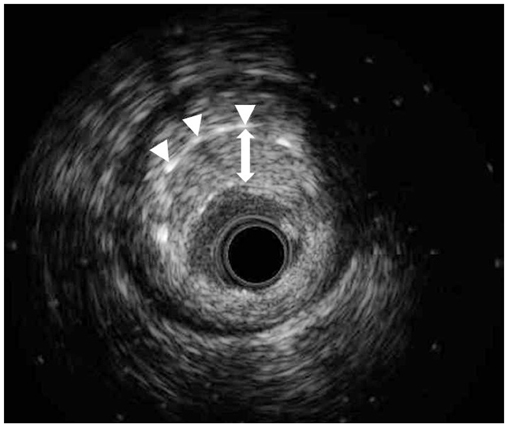Korean Circ J.
2012 Sep;42(9):646-649. 10.4070/kcj.2012.42.9.646.
Acute Stent Thrombosis and Heparin Induced Thrombocytopenia in a Patient With ST-Segment Elevation Myocardial Infarction
- Affiliations
-
- 1Division of Cardiology, Department of Internal Medicine, Dongsan Medical Center, Keimyung University College of Medicine, Daegu, Korea. hippsons@dsmc.or.kr
- KMID: 2297899
- DOI: http://doi.org/10.4070/kcj.2012.42.9.646
Abstract
- Heparin is an essential drug in the treatment of acute coronary syndrome and it is used during percutaneous coronary intervention (PCI). Heparin-induced thrombocytopenia (HIT), albeit a serious complication of heparin therapy characterized by thrombocytopenia and high risk for venous and arterial thrombosis, has rarely been previously reported during PCI. We report a case of an acute stent thrombosis due to an unusual cause, HIT during primary PCI, in a patient with acute myocardial infarction.
Keyword
MeSH Terms
Figure
Reference
-
1. Iakovou I, Schmidt T, Bonizzoni E, et al. Incidence, predictors, and outcome of thrombosis after successful implantation of drug-eluting stents. JAMA. 2005. 293:2126–2130.2. Mauri L, Hsieh WH, Massaro JM, Ho KK, D'Agostino R, Cutlip DE. Stent thrombosis in randomized clinical trials of drug-eluting stents. N Engl J Med. 2007. 356:1020–1029.3. Wenaweser P, Rey C, Eberli FR, et al. Stent thrombosis following baremetal stent implantation: success of emergency percutaneous coronary intervention and predictors of adverse outcome. Eur Heart J. 2005. 26:1180–1187.4. Fujii K, Carlier SG, Mintz GS, et al. Stent underexpansion and residual reference segment stenosis are related to stent thrombosis after sirolimus-eluting stent implantation: an intravascular ultrasound study. J Am Coll Cardiol. 2005. 45:995–998.5. King SB 3rd. 2009 update of the ACC/AHA guidelines for the management of patients with ST-elevation myocardial infarction and guidelines on percutaneous coronary intervention: what should we change in clinical practice? Pol Arch Med Wewn. 2010. 120:6–8.6. Gupta BK, Savage MP, Brest AN. Acute myocardial infarction during coronary angioplasty associated with heparin-induced thrombocytopenia. Cathet Cardiovasc Diagn. 1995. 35:42–46.7. Antman EM, Anbe DT, Armstrong PW, et al. ACC/AHA guidelines for the management of patients with ST-elevation myocardial infarction--executive summary. A report of the American College of Cardiology/American Heart Association Task Force on Practice Guidelines (Writing Committee to revise the 1999 guidelines for the management of patients with acute myocardial infarction). J Am Coll Cardiol. 2004. 44:671–719.8. Babuin L, Pengo V. Argatroban in the management of heparin-induced thrombocytopenia. Vasc Health Risk Manag. 2010. 6:813–819.9. Dasari TW, Pappy R, Hennebry TA. Acute stent thrombosis associated with heparin-induced thrombocytopenia and abciximab-induced profound thrombocytopenia. J Invasive Cardiol. 2011. 23:E5–E8.10. Hussain F, Philipp R, Zieroth S. HITT and stent thrombosis: a "clinical" diagnosis not to be missed. Int J Cardiol. 2009. 133:e11–e13.11. Warkentin TE. Heparin-induced thrombocytopenia: pathogenesis and management. Br J Haematol. 2003. 121:535–555.12. Smith SC Jr, Feldman TE, Hirshfeld JW Jr, et al. ACC/AHA/SCAI 2005 guideline update for percutaneous coronary intervention--summary article: a report of the American College of Cardiology/American Heart Association Task Force on Practice Guidelines (ACC/AHA/SCAI Writing Committee to update the 2001 Guidelines for Percutaneous Coronary Intervention). Catheter Cardiovasc Interv. 2006. 67:87–112.13. Matsue H, Masai T, Yoshikawa Y, Kawamura M. Serious acute coronary thrombosis associated with heparin-induced thrombocytopenia in off-pump coronary artery bypass grafting. Interact Cardiovasc Thorac Surg. 2010. 11:188–190.14. Brieger DB, Mak KH, Kottke-Marchant K, Topol EJ. Heparin-induced thrombocytopenia. J Am Coll Cardiol. 1998. 31:1449–1459.15. Lewis BE, Matthai WH Jr, Cohen M, Moses JW, Hursting MJ, Leya F. Argatroban anticoagulation during percutaneous coronary intervention in patients with heparin-induced thrombocytopenia. Catheter Cardiovasc Interv. 2002. 57:177–184.16. Rössig L, Genth-Zotz S, Rau M, et al. Argatroban for elective percutaneous coronary intervention: the ARG-E04 multi-center study. Int J Cardiol. 2011. 148:214–219.17. Van Werkum JW, Heestermans AA, Zomer AC, et al. Predictors of coronary stent thrombosis: the Dutch Stent Thrombosis Registry. J Am Coll Cardiol. 2009. 53:1399–1409.
- Full Text Links
- Actions
-
Cited
- CITED
-
- Close
- Share
- Similar articles
-
- The Management of Heparin-induced Thrombocytopenia with Thrombosis That Developed after Aortic Dissection Surgery
- The Management of Heparin-induced Thrombocytopenia with Thrombosis after Open Heart Surgery: A Case Report
- ST-Segment Elevation Acute Myocardial Infarction Secondary to Native Aortic Valve Thrombus
- A Case of Acute ST-Segment Elevation Myocardial Infarction Mimicking Stress Induced Cardiomyopathy; Demonstration of Typical Echocardiographic Finding Correlated with Unusual Distribution of Left Anterior Descending Coronary Artery
- A Case of Delayed Onset Tirofiban Induced Thrombocytopenia in a Chronic Renal Failure Patient




